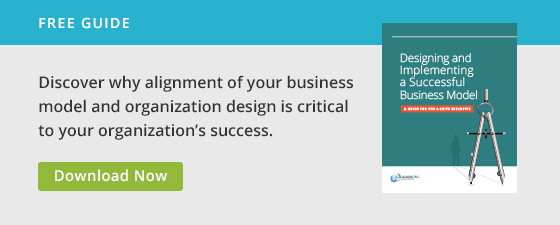Making the Hard Choices through Organization Alignment
Every organization has finite resources. When you’re building a home and finalizing the detailed blueprints, you may notice you can’t afford to add all items on your wish list. You’ll have to choose. What stays? What goes? The pool or the home-automation package? The Viking range or the palatial master suite?
It all boils down to hard choices.
It is the same in business—you need to make do with the resources at hand. You simply won’t be able to accomplish everything, at least not all at once.
The key is making sure the decisions you make align with your business priorities. Decide where to concentrate both your efforts and resources so that you deliver the most bang for your buck within your strategy.
Getting the Right Input
Change requires a collective effort and the right blend of people. In an ideal world, organization alignment (from business model development through the implementation of your organization design) should cascade throughout your organization from you, to other organizational leaders, and eventually to the employees at large.
Remember to partner with people not in direct control of the organization such as customers, suppliers, and partners. With the right people involved in the design of the business model and alignment of organizational choices, you gain a big-picture perspective that will ensure the transformation process is connected to the marketplace and leads to success.
Align All Elements of Your Organization to Your Strategy
In building a home, your contractors are the lifeblood of your home’s construction. Each delivers a part of your building plan. Their input is essential and their jobs are interconnected. Plumbing can’t be installed if the house hasn’t been framed. Electrical wiring must go in before the drywall is up. Painting can only be completed once the drywall is up, taped, mudded, and textured.
Your organization has similar moving parts that work together to form a whole:
- Work processes
- Structure and governance
- Information and metrics
- People and rewards
- Leadership and culture
- Continuous improvement
When implementing change, you should consider all areas.
Become An Alignment Leader
Successful organization alignment efforts are often the result of leaders embracing the role of Alignment Leader. A good organization alignment leader embodies the qualities of a chief alignment officer who:
- Understands that choices/trade-offs need to be made and sticks to the “Nos” and embraces the necessary “Yeses”. He/she also keeps the ship running while emerging processes and structures come into play.
- Adopts an alignment mentality—looking at all aspects of the organization and encouraging others to consider how alignment choices impact the whole system.
- Embraces the change concept and is committed to getting everyone on board—insisting on change management in the process.
- Maintains organization alignment and manages change by building capability – working with others to achieve it. Even when you think you’re done, you’ve got to consistently revisit the process – reevaluating what’s working and what’s not, tweaking and reconfiguring, and adjusting with the ebb and flow of the marketplace. You can’t do this alone; alignment leaders teach others in the organization to think systemically and recognize misalignments that need to be addressed.
- Makes sacrifices in the best interests of the organization. A good alignment leader has the ability to leverage strategy to reduce waste AND grow at the same time. He or she is adept at shifting resources from less strategic work to ensure that the most strategic work is supported.
- Absorbs complexity: Alignment leaders help their organization drive to the customer’s “wants” and needs rather than the other way. Rather than focus on the organization’s products and services, investments are made in designing the experience or solution so that it solves or addresses a customer’s needs.
- Become more nimble: Working through the organization alignment process, every aspect needs to be architected for decisive, swift response to market changes without inhibiting growth. It’s an ongoing process if your organization intends to remain competitive.
Absorb Complexities
In the book, Mastering the Cube, I explore the importance of absorbing the complexities of customers. Absorbing complexity involves moving away from the notion that it’s enough to make a great product or deliver an effective service. You must develop a more differentiated experience. This demands that leaders and organizations build organization capabilities that will absorb complexities that customers no longer want to manage (e.g., scheduling delivery of products, coordinating delivery of services, etc.)
Southwest Airlines is a good example of an organization with a successful business model that, with the right planning, can adjust to absorb complexities when necessary. Before 9/11, all that was needed to board a Southwest flight was a plastic card with a boarding number on it. It was fast and cost-efficient. Post–9/11 regulations changed that. Southwest was required to track who was boarding their planes and whether their luggage was on the same flight as the paying passenger. This new complexity could’ve changed the customer experience, but Southwest found a way to maintain the simplicity that appealed to customers while addressing the new regulatory requirements. Customers can still sit wherever they choose, but only according to their boarding group and boarding number—both of which act as their assigned seat. Southwest maintained the simplicity and efficiency of the process and still complied with Homeland Security’s requirements.
To meet the demands of a new environment, selective design choices often have to be made that may increase internal complexity, but can still deliver a seamless, integrated, and differentiated experience for customers. Frequently, the choices you will have to make will be harder for your organization but easier for your customers.
No matter what drives the complexity, it demands more clarity in your business model and organization design. Being a good chief alignment officer means sticking to trade-offs and aligning organization choices to deliver – even if that means making life simpler for your customers at the expense of absorbing complexity in your organization.






